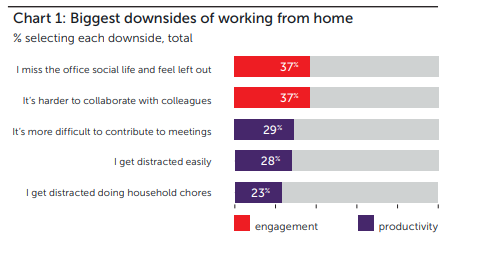From Hybrid to Hub and Spoke: The evolving work models of the future

If you are done with sitting at home in front of your laptop, trying to adapt to this new normal of work, and are desperately craving for that good old human interaction which your office afforded, you are not the only one. A major survey of white-collar workers around the world, published by Barco, a global leader in visualization and collaboration solutions, has revealed surprising findings about employee expectations for the workplace in the aftermath of the COVID-19 pandemic. And not everyone is feeling gung-ho about working from home anymore.
The study – which surveyed 1,750 employees around the world (250 each from the United States, United Kingdom, France, Germany, Australia, India, and United Arab Emirates) through global research panel provider Dynata – found that only 15% of employees want to continue to work from home full-time after COVID-19 restrictions are lifted. Working from home clearly lost its sparkle, since nearly half of those surveyed said they enjoy working from home less now than they did at the start of the pandemic, citing challenges in collaborating with colleagues, struggling to contribute to meetings, and missing the social side of office life as the main reasons for wanting to return to the office.
Moreover, 42% globally stated working from home stifles their creativity; 37% miss office social life and find it harder to collaborate when working remotely; and 45% find it easier to work with colleagues in the office.
Clearly, remote work is no more that enjoyable and the numbers seem to say that.
Remote Working and the Missing Human Connection Element
For many people, the charm of remote work is wearing off as they miss the social life and feel left out when working from home. Secondly, people also find it harder to collaborate with colleagues or contribute to meetings. Or simply, they also get distracted easily.

When asked about their preference for work from home and office, people on an average want to work two days from home only, and the rest from office or a co-working space or a satellite office.

In short, people still find it important to meet face-to-face — just not every day, in the same office. And this has made companies rethink working models. So while earlier, everyone was high on reducing office space and offer more flexibility to employees, now companies are beginning to experiment with mixing remote and office work — or what we know as hybrid working. Employees are keen on a hybrid workplace model, where most of their time is spent in the office but they have the flexibility and freedom to work from home when it works best for them. Further, employees are looking for organizations to invest in a technology-driven hybrid working environment post-COVID-19.
Hybrid Workplaces for the New Normal: Pros and Cons
While the hybrid model gets over the limitations of a complete remote working model and allows teams to interact, meet in person and collaborate together in a better way, it also has its own set of challenges. Firstly, employees currently split between home and office can find it hard to manage and it could create divisions between the in-crowd and at-home crowd. It is easier to have a team being fully remote rather than some in a room and some remote.
Also, while some may prefer the division between work and home, but some employees might not prefer working from home at all. Given that we are in a transition and experimentation mode of working on account of the pandemic, it might be still too early for companies to commit to hybrid models permanently. Thus managers should where ever possible to experiment with new work arrangements and gauge the impact on employee attitudes and performance. So leaders right now should first experiment and determine and not necessarily be in a hurry to adopt the most viable and effective long-term work arrangement. One way could be to test the hybrid model one department at a time and then revise it and take it forward accordingly.
Then again, hybrid work models require clarity about job roles to decide which tasks are best suited to home such as writing, and which should be done in-office such as ideating or brainstorming.
The model also calls for greater planning as it requires a great deal of co-ordination between workplace facilities management and human resources. A thinly populated office might reinforce isolation and also put teams at risk of going back into silos.
Finally, the one most important thing for the hybrid model to work is technology. Organizations need to upgrade their videoconferencing and collaboration tools for this model to work for everyone-be it at home or office.
Why Technology is an important driver of Hybrid Workplace Model
Lieven Bertier, Segment Marketing Director Workplace, Barco said, “There is now a burning desire from employees to get back to normal, with the freedom, flexibility, and facilities to adopt a better blend of home and office working. Technology will be crucial to achieving this blend. To survive, rebuild and eventually thrive again in the post-pandemic world, businesses will need to invest in new technologies, redesign or at least reconfigure their office spaces, and give their employees the tools they need to work in the best way possible, no matter where they are located or how they choose to connect. If they can make these changes quickly and effectively, they will be fit for the future and ready to deal with the challenges we all face over the coming months and years, and to seize the opportunities that will surely follow.”
Globally, over half of the workforce wants to see meeting room technology designed for more usability and connectivity in the next year. 56% of the global employees are looking for apps that enable users to join a video conference in one click while 67% think Artificial Intelligence should be in place to provide feedback on participants and their engagement in meetings.
 The findings of the Barco study highlight that most employees around the world are ready to embrace a more blended approach to work. What’s also clear is that the greatest remote working experiment in living history has not killed the office, far from it: employees desperately want to go back to a world where they see and interact with their colleagues face-to-face. They just want to do it on their terms, and with a greater degree of flexibility offered by their employers.
The findings of the Barco study highlight that most employees around the world are ready to embrace a more blended approach to work. What’s also clear is that the greatest remote working experiment in living history has not killed the office, far from it: employees desperately want to go back to a world where they see and interact with their colleagues face-to-face. They just want to do it on their terms, and with a greater degree of flexibility offered by their employers.
Is Hub and Spoke Model the answer?
One model that might suit hybrid work is the hub and spoke model, whereby a company has a main office and satellite ones, allowing workers to meet up closer to home. These satellite offices or neighborhood hubs where clusters of employees live would reduce commuting time and also bring together a section of workers from various roles, giving them a chance to build community based on the common experience of where they live. This would also help in breaking inter-team silos. These hubs will also ensure business continuity in the face of rapidly changing business conditions and at the same time, offer flexibility to employees to work closer to their homes.
Also, while collaboration technologies provided the vital connection between people during the lockdown and helped businesses stay in touch and keep operating, but this is not enough. Now, investment in workplace technologies must focus on facilitating interactions that are more natural, more authentic, and bring the human element back to our virtual interactions.
The message is clear- people want to see their companies invest in collaboration technologies. In the long term, businesses will need to be inventive and adaptable in order to rebuild and eventually thrive again in the post-pandemic world. They will need to invest in new technologies, redesign or at least reconfigure their office spaces, and give their employees the tools they need to work in the best way possible, no matter where they are located or how they choose to connect.
Ultimately, whether you adopt the hybrid model or the hub and spoke model, one thing is clear- work environments are continuing to evolve and the future will likely involve a greater mix of office environments in response to the increased demand for flexible offices and the growth in remote working. Also, the need for face-to-face interaction s not going away anywhere nor are we completely doing away with the traditional office. We need to find the right balance between physical contact and virtual collaboration, supported by the right technologies, in order to help employees adapt to the changes that are happening in every aspect of their lives and in a true sense, be future-ready for any challenges.

















